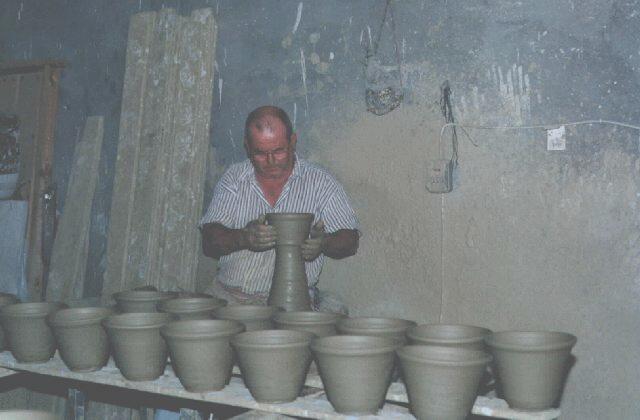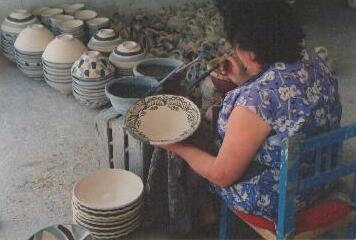 "The others don't use local clay any more," he told me, "they use SIO 2."
"The others don't use local clay any more," he told me, "they use SIO 2."Rosa returned to her little work chair and I went over to the wheel where her husband Manuel was throwing flowerpots from the mound of local clay. He still used the same type of motorized kickwheel that I had known for the past 25 years. "The others don't use local clay any more," he told me, "they use SIO 2."
"The others don't use local clay any more," he told me, "they use SIO 2."
I knew SIO 2, a good, red throwing clay from Gerona in N.E. Spain. I had used it myself when living in Níjar. It was fairly smooth and lacked the impurities of the local clay which was prone to lime blow-outs. Of course, this defect could be remedied by more thorough filtering.
 "But it's not just the clay that has changed," continued Manuel, "They don't even do much throwing now - they use molds; plaster molds and a mechanical arm on the wheel which does the throwing and makes every piece exactly the same."
"But it's not just the clay that has changed," continued Manuel, "They don't even do much throwing now - they use molds; plaster molds and a mechanical arm on the wheel which does the throwing and makes every piece exactly the same."
I realized that he was referring to a jolleying attachment. "Who started that?" I asked.
My nephew, Baldomero," interjected Rosa who had abandoned her chair. "You should see him now! He employs twenty people and has a real factory! They decorate the pots with new geometrical and floral designs. They export stuff all over Europe."
I remembered Baldomero well; once I used to give him French lessons. He finished school and joined his parents, Baldomero and Francisca, working at the wheel until they retired. Then he had taken over the place and expanded the business, opening up the new premises some distance from the village of Níjar.
"How about the other potters?" I asked, "Do any of them still work in the traditional way?"
"Yes," said Rafael. "Of course, they all use the fritted glaze now, and we all have gas kilns, but Góngora still uses his wheel and he still fires his old kiln."
"Will you go over to using molds, Manuel? Rosa, will you give up slip-trailing for the new designs?"
They both laughed, "At our age? No, we are too stuck in our ways. We'll just go on as we are, doing what our parents taught us until we can work no longer....."
As they spoke I watched their son Rafael who was 34 years old, just like my own eldest boy, in fact they had attended the local school together. He was carrying the freshly thrown flowerpots, loaded on to long wooden boards which he skilfully balanced on his shoulder, before placing them in layers on the drying-cart which stood outside in the midday sun. When Manuel and Rosa eventually retire, Rafael will take over the family business. Will he, like his cousin Baldomero, turn to mechanical aids and modern methods of mass-production? And Góngora, whom I did not have time to visit, will he be the last potter in Níjar to fire his wood-fuelled kiln? The tourists who visit the village and buy pots in the many craftstores which have spread from Las Eras to the wide new main street with its modern buildings - these people don't know the difference. They think that they are buying a piece of living history. All the pots are better finished now, even those made by Manuel and Góngora. Manuel now has a grinding-wheel to smooth the feet, removing drips of glaze and kaolin slip. The old tripod stilts are no longer used and now no pot or plate has the three tell-tale scars on its glossy surface. Some of Baldomero's incised geometrical designs are most attractive, and a real improvement on the very simple traditional patterns. The new commercial glaze is certainly less toxic to potential users than the old galena one. The fact that it crazes horribly does not seem to worry anyone. They know nothing about glaze chemistry and do not realize that a good fit could probably be obtained with small adjustments to the new glaze. These potters have had no instruction in such matters. They were told that their old glaze was dangerous and provided with sacks of anonymous white powder to replace it. All they know is that it, too, contains lead, but that the lead has been fritted to lessen toxicity. There is no longer any need to keep canaries as 'witnesses'. As I thanked Manuel and Rosa for letting me write this article, I took one last look at the empty birdcage hanging on the wall. For me, it marked the end of an era.

Copyright F. Melville, 1997